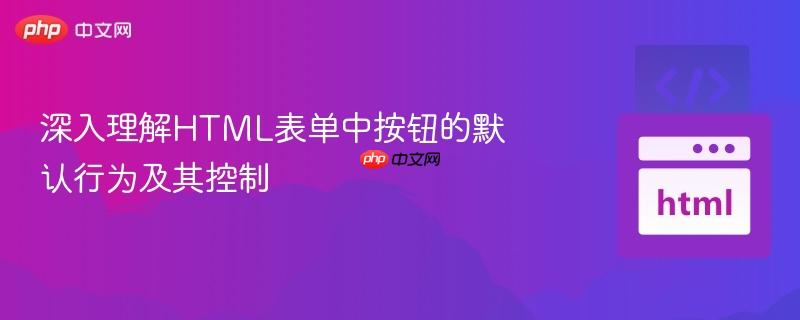
当html中的<button>元素被放置在<form>标签内部时,其默认行为会从简单的点击事件触发变为触发表单提交。这是因为按钮在表单内默认类型为submit。为避免意外的表单提交并确保javascript事件按预期执行,开发者应显式设置按钮的type属性为"button",或者在表单的submit事件中使用event.preventdefault()来阻止默认行为。
在HTML中,<button>元素的功能强大且灵活。然而,当它被包含在<form>元素内部时,其默认行为可能会出乎意料。一个常见的误解是,所有按钮都只响应其JavaScript click 事件。但实际上,如果一个<button>元素没有明确指定type属性,并且它位于一个<form>标签内部,浏览器会将其默认视为type="submit"。这意味着,除了触发其绑定的click事件外,它还会尝试提交其所属的表单,导致页面刷新或数据发送到服务器,这往往会中断或覆盖预期的JavaScript逻辑。
例如,考虑以下HTML结构和JavaScript代码:
<html lang="en">
<head>
<meta charset="utf-8" />
<title>Button Behavior Example</title>
</head>
<body>
<input id="expertiseReq" placeholder="leave blank for any skill level" />
<input id="locationReq" placeholder="leave blank for any location" />
<!-- 按钮位于表单之外,默认行为是触发点击事件 -->
<button id="gatherNames">Click to Get List of Player Names</button>
<blockquote id="playerNamesGoHere">No Player Names Loaded</blockquote>
<script src="SBPscript.js"></script>
</body>
</html>const gatherPlayersButton = document.getElementById('gatherNames');
const areaForPlayerNames = document.getElementById('playerNamesGoHere');
const summon_players = () => {
// ... 获取输入值并构建请求字符串 ...
let eR = document.getElementById('expertiseReq').value || "None";
let lR = document.getElementById('locationReq').value || "None";
let tagsString = eR + "," + lR;
fetch(`/battle?tags=${tagsString}`, { method: "GET" })
.then((response) => response.text())
.then((text) => {
areaForPlayerNames.innerText = text;
});
};
gatherPlayersButton.addEventListener("click", () => summon_players());在这种情况下,gatherNames按钮独立于任何表单,其click事件会正常触发summon_players函数,并通过fetch请求更新blockquote中的内容。
然而,如果我们将输入字段和按钮用<form>标签包裹起来:
立即学习“前端免费学习笔记(深入)”;
<form>
<input id="expertiseReq" placeholder="leave blank for any skill level" />
<input id="locationReq" placeholder="leave blank for any location" />
<!-- 按钮位于表单内部,默认类型为 "submit" -->
<button id="gatherNames">Click to Get List of Player Names</button>
</form>
<blockquote id="playerNamesGoHere">No Player Names Loaded</blockquote>此时,当点击gatherNames按钮时,除了触发其click事件外,浏览器还会尝试提交表单。如果表单没有明确的action属性,通常会导致页面刷新,从而中断JavaScript的执行,使得fetch请求返回的数据无法更新到blockquote中。
要解决这种意外的表单提交行为,有以下两种主要方法:
最直接和推荐的方法是为按钮显式指定type="button"。这将告诉浏览器该按钮仅用于触发客户端脚本,而不是提交表单。
<form> <input id="expertiseReq" placeholder="leave blank for any skill level" /> <input id="locationReq" placeholder="leave blank for any location" /> <!-- 明确指定 type="button",阻止默认的表单提交行为 --> <button type="button" id="gatherNames">Click to Get List of Player Names</button> </form> <blockquote id="playerNamesGoHere">No Player Names Loaded</blockquote>
通过添加type="button",按钮的click事件将像预期一样工作,而不会触发表单提交。
如果你的确需要按钮在表单内部,并且希望通过JavaScript完全控制表单的提交逻辑(例如,通过AJAX提交数据),你可以监听表单的submit事件,并使用event.preventDefault()来阻止其默认的提交行为。
<form id="myForm"> <input id="expertiseReq" placeholder="leave blank for any skill level" /> <input id="locationReq" placeholder="leave blank for any location" /> <button id="gatherNames">Click to Get List of Player Names</button> </form> <blockquote id="playerNamesGoHere">No Player Names Loaded</blockquote>
const myForm = document.getElementById('myForm');
const gatherPlayersButton = document.getElementById('gatherNames');
const areaForPlayerNames = document.getElementById('playerNamesGoHere');
const summon_players = () => {
let eR = document.getElementById('expertiseReq').value || "None";
let lR = document.getElementById('locationReq').value || "None";
let tagsString = eR + "," + lR;
fetch(`/battle?tags=${tagsString}`, { method: "GET" })
.then((response) => response.text())
.then((text) => {
areaForPlayerNames.innerText = text;
});
};
// 监听表单的 submit 事件,并阻止其默认行为
myForm.addEventListener("submit", (e) => {
e.preventDefault(); // 阻止表单提交
console.log("Form submission prevented. Now handling with JavaScript.");
// 可以在这里调用 summon_players() 或其他自定义提交逻辑
summon_players();
});
// 如果按钮有额外的点击事件,也可以保留
gatherPlayersButton.addEventListener("click", () => {
console.log("Button clicked.");
// 注意:如果表单的 submit 事件已经处理了逻辑,这里可能不需要重复调用 summon_players()
// 或者,如果按钮的点击事件是独立的,则可以在这里调用
});在这种情况下,myForm的submit事件会被捕获,e.preventDefault()会阻止页面刷新,然后你可以执行自定义的JavaScript逻辑。
除了理解按钮的默认行为,以下是一些通用的Web开发最佳实践,有助于提高代码质量、可维护性和调试效率:
命名约定:
脚本加载:
变量声明:
比较运算符:
处理查询参数:
fetch请求错误处理:
fetch(`/battle?tags=${tagsString}`)
.then(response => {
if (!response.ok) {
throw new Error(`HTTP error! status: ${response.status}`);
}
return response.text();
})
.then(text => {
areaForPlayerNames.innerText = text;
})
.catch(error => {
console.error("Fetch error:", error);
areaForPlayerNames.innerText = "Error loading player names.";
});文件和文件夹命名:
理解HTML中<button>元素的默认行为,尤其是在<form>内部时,是避免常见前端陷阱的关键。通过显式设置type="button"或在表单的submit事件中调用event.preventDefault(),可以有效控制按钮的行为,确保JavaScript逻辑按预期执行。同时,遵循良好的编码实践将显著提升项目的质量和可维护性。
以上就是深入理解HTML表单中按钮的默认行为及其控制的详细内容,更多请关注php中文网其它相关文章!

HTML怎么学习?HTML怎么入门?HTML在哪学?HTML怎么学才快?不用担心,这里为大家提供了HTML速学教程(入门课程),有需要的小伙伴保存下载就能学习啦!

Copyright 2014-2025 https://www.php.cn/ All Rights Reserved | php.cn | 湘ICP备2023035733号